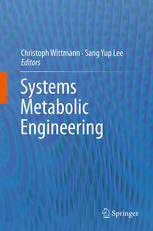
Systems Metabolic Engineering PDF
Preview Systems Metabolic Engineering
Systems Metabolic Engineering Christoph Wittmann Sang Yup Lee l Editors Systems Metabolic Engineering Editors ChristophWittmann SangYupLee InstituteofBiochemicalEngineering MetabolicandBiomolecularEngineering BraunschweigIntegratedCenterfor NationalResearchLaboratory SystemsBiology(BRICS) DepartmentofChemicalandBiomolecular CenterforPharmaceuticalEngineering Engineering(BK21Program) TechnischeUniversita¨tBraunschweig CenterforSystemsandSynthetic Braunschweig,Germany Biotechnology InstitutefortheBioCenturyKAIST Daejeon,RepublicofKorea ISBN978-94-007-4533-9 ISBN978-94-007-4534-6(eBook) DOI10.1007/978-94-007-4534-6 SpringerDordrechtHeidelbergNewYorkLondon LibraryofCongressControlNumber:2012941228 #SpringerScience+BusinessMediaDordrecht2012 Thisworkissubjecttocopyright.AllrightsarereservedbythePublisher,whetherthewholeorpart of the material is concerned, specifically the rights of translation, reprinting, reuse of illustrations, recitation,broadcasting,reproductiononmicrofilmsorinanyotherphysicalway,andtransmissionor informationstorageandretrieval,electronicadaptation,computersoftware,orbysimilarordissimilar methodologynowknownorhereafterdeveloped.Exemptedfromthislegalreservationarebriefexcerpts inconnectionwithreviewsorscholarlyanalysisormaterialsuppliedspecificallyforthepurposeofbeing enteredandexecutedonacomputersystem,forexclusiveusebythepurchaserofthework.Duplication of this publication or parts thereof is permitted only under the provisions of the Copyright Law of thePublisher’slocation,initscurrentversion,andpermissionforusemustalwaysbeobtainedfrom Springer.PermissionsforusemaybeobtainedthroughRightsLinkattheCopyrightClearanceCenter. ViolationsareliabletoprosecutionundertherespectiveCopyrightLaw. Theuseofgeneraldescriptivenames,registerednames,trademarks,servicemarks,etc.inthispublication doesnotimply,evenintheabsenceofaspecificstatement,thatsuchnamesareexemptfromtherelevant protectivelawsandregulationsandthereforefreeforgeneraluse. While the advice and information in this book are believed to be true and accurate at the date of publication,neithertheauthorsnortheeditorsnorthepublishercanacceptanylegalresponsibilityfor anyerrorsoromissionsthatmaybemade.Thepublishermakesnowarranty,expressorimplied,with respecttothematerialcontainedherein. Printedonacid-freepaper SpringerispartofSpringerScience+BusinessMedia(www.springer.com) To Heike, Isabelle, Felix and Florian from Christoph and to Hyejean and Gina from Sang Yup for their love, support and inspiration Preface The integration of systems-wide omics approaches, genome-scale modeling and simulation, synthetic biological approaches, and even evolutionary engineering is opening a new era of industrial strain engineering – the design-based creation of tailor-made overproducers that are optimized at the global level. This integrated approach of metabolic engineering is now called systems metabolic engineering. At the entry into a new millennium, facing strong needs for a novel bio-economy due to global warming and shortage of fossil fuels, this seems one of the most relevant and promising areas of research and industrial application. The present bookisdevotedtothisfascinatingareaofsystems-wideanalysisandengineeringof cellular metabolism. Through a series of exciting chapters, world leading experts provide us with up-front approaches to analyze, model and re-design biological systemstowardsdesiredpropertiesandenrichthisbyreal-caseapplicationsforthe mostrelevantworkhorsesinindustrialbio-production. The book starts with computational and experimental methods on the systems- wideanalysisofbiologicalsystems,theentryandbasistocreateunderstandingand enable knowledge-based systems metabolic engineering. In Chap. 1, Professors Lee and Palsson together with their teams combine their pioneering expertise on computational modelingofgenome-scalenetworks,the tin-opener inmanyof the successfulprojectsonsystemsmetabolicengineeringreportedtoday.Theyprovide the full picture, touching metabolic networks, transcriptional networks and cell- signaling networks and include interesting case studies on the biological systems picked up in the later application chapters of the book. Chapter 2 by Professor Palsson and colleagues extends the stoichiometric modeling of Chap. 1 to kinetic models of metabolism, crucial to describe systems dynamics. Their contribution gives valuable hands-on advice for the creation of kinetic models, provides the fundamentalmathematicsandcloseswithpracticalapplicationexamples.Chapter3 by Professor Shimizu’s group complements the dry lab analysis of networks via wet lab approaches, covering state-of-art omics technologies. They describe how vii viii Preface thoroughlydesignedexperimentalstudiesdeliverdeepunderstandingofindustrial microorganisms and how metabolic engineers can efficiently exploit this towards optimizedstrains. Theaboveapproachesonsystems-widecomputationalandexperimentalanalysis of biological systems, which form the initial part of the book, provide design strategies for superior cell factories that have to be implemented on the DNA level. The more we want to shape and create, the larger the genetic changes necessary. In this regard, Chap. 4 by Professor Panke and co-workers discusses how to efficiently translate design concepts into synthetic DNA sequences. The authorsespeciallyfocusonnovellarge-scalesyntheticengineeringapproachesand provideuswithaninterestingviewoncompletelydesign-basedsyntheticsystems. Chapters5,6, 7,8,9and10pickup most relevant industrial workhorses from the groups of bacteria, yeasts and fungi and illustrate how systems metabolic engineering is used today for next-level strain and bioprocess development. Chapter 5 by the group of Professor Lee focuses on Escherichia coli, probably the most deeply studied microorganism on the systems level. Their set of exam- plesonawidesetofproductsunderlinehowadvancedweareincreatingtailor- made E. coli cell factories and what is needed to go even further. In Chap. 6, Professor Wittmann and his team review systems metabolic engineering of Corynebacterium glutamicum. Theyexplainhowthisgram-positivesoilbacterium canbetailoredtoconvertabroadspectrumofrenewablerawmaterialsintovarious chemicals,fuels,materialsortherapeuticsandthus,similarly,toE.coli,isbecominga successfulbio-productionplatform.Chapter7byProfessorPapoutsakisandcollea- gues deals with Clostridium acetobutylicum, a famous bacterium for production of solventssincetheverybeginningofindustrialbiotechnologyalmosta100yearsago. Theircontributionfocusesonimprovedtolerancefromasystemsviewpoint,akey target of superior strains, and especially valid towards high-level production of the often unnatural chemicals toxic for the cell. Chapters 8 and 9 highlight eukaryotic production systems. In Chap. 8, Professor Heijnen’s group describe systems-level designofPenicilliumchrysogenum,well-knownforitshighrelevanceforantibiotics production and a model system for the rich set of industrial processes with other filamentous fungi. Theircontribution nicelyrecruitsmodelingtoelucidatefunction andcontrolofmetabolismforstraindesign.Chapter9byProfessorNielsenandco- workersdealswithyeastandillustrateshowomicstechnologiescanbeintegratedwith syntheticbiologyforrationalDNAmodificationintoaknowledge-basedframework forsystemsmetabolicengineering.Theycomplementthisbytwocasestudiesfrom biofuelproduction,whichareamongthemostrelevantbioprocessesinyeastindustrial biotechnology.InChap.10,ProfessorKondoandhisteamprovideuswithinteresting examplesonsystemsmetabolicengineeringofcellularpropertiesthatarecrucialto successfullyintegratecellfactoriesintotherisingconceptofbiorefinery.Inthisregard their review discusses improved utilization of renewable raw materials – direct conversionofthemainlymixed,polymericsubstratesaswellasimprovedtolerance totoxicingredients. Preface ix Chapter 11 closes the book by opening a new door. Professor Stephanopoulos and colleagues illustrate how we can exploit ideas and tools of systems metabolic engineeringandsystemsbiologytoaddresskeyquestionsinmedicine.Theircontri- butiononcancerasametabolicdiseasemightstimulatetofurtherextendtheapplica- tionoftheengineeringconceptsdescribedthroughoutthebooktowardsanewfieldof research. As compiled in this book, we are now reaching the level of global analysis, designandengineeringofbiologicalsystems.Thisprovidesacornucopiaofnovel possibilities–sustainablesupplyofchemicals,materialsandfuelsinaneweraof bio-production as well as tailor-made therapies of threatening diseases. We hope that the book is interesting and valuable for researchers and engineers from the various disciplines that are all integrated into the field. Thanks to the worldwide experts and their excellent contributions, which are greatly appreciated, this book hopefullysetsamilestonewithperpetualvalue.Wewouldliketodeeplythankthe membersofourlabs,ledbyDr.JudithBecker,fortheirgreateffortsineditingand formattingthebook.Finally,wewouldliketothankthepeopleatSpringerfortheir assistanceintheproduction.Admittedly,wearestillawayfromtheimmaculatecell factory,butthewaytowardsithasbecomevisible–anditisaprivilegetowalkon andshareitwithyou. TUBraunschweig,Germany ChristophWittmann KAIST,Daejeon,RepublicofKorea SangYupLee
